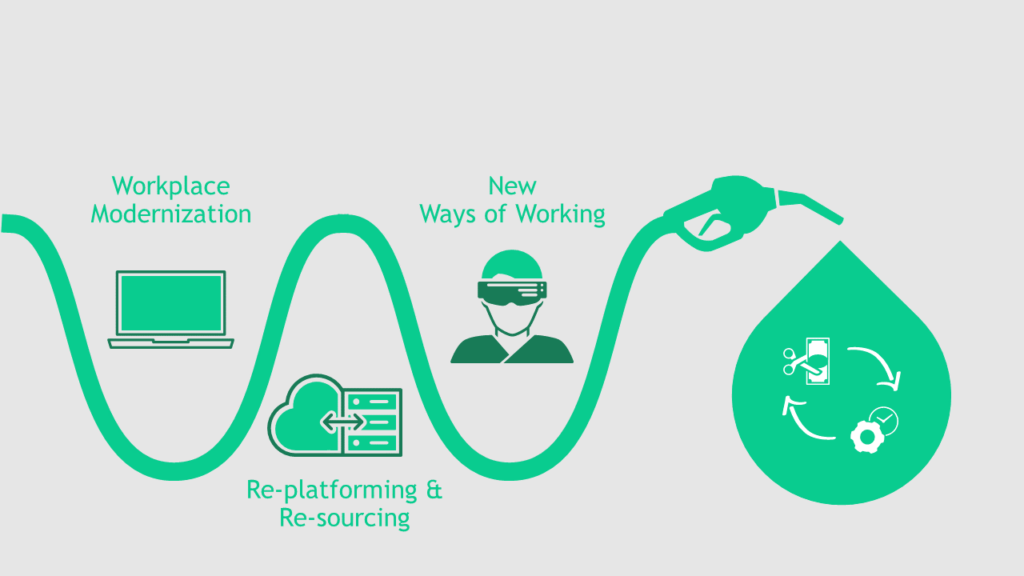Since the beginning of the pandemic, many companies experienced a radical change in their business operations unlike any they had seen before. This included switching to remote working, requiring the IT department to rethink processes and infrastructure within just a few days or weeks. Long avoided modernization measures had to be realized at short notice.
At the same time, the overall uncertainty about the economic situation forced many companies to enter into a defensive, cost-avoiding “crisis mode.” Although some global economies are slowly going back to normal, supply pipelines cannot keep up with the erratic surge in demand following the former slack and respective capacity reduction. These tailbacks, or lack of catch-up effects in some industries, are forcing companies to introduce large efficiency improvements and restructuring programs that also affect corporate IT.
Example: By the end of 2020, a leading European logistics provider announced yet another restructuring program to reduce its operating cash flow by €100M per month. Such efficiency programs usually require heavy adjustments to corporate structures, organization, and operations.

The IT function plays an essential role in realizing savings in spending by reassessing projects and operating spend. However, by choosing the right innovative measures, efficiency improvement can also be a step change in modernizing your IT. Instead of simply canceling and avoiding IT spending, BCG Platinion suggests leveraging efficiency programs as a vehicle for the long overdue modernization of IT capabilities—to achieve a competitive and future-ready tech function. Here’s how to achieve it with three measures:
1. Modernize the workplace to reduce recurring hardware spend
The introduction of remote working has presented immense challenges for corporate IT departments and especially their network and security infrastructure. Guaranteeing seamless operations of all IT services via VPN and other remote connections requires a scalable infrastructure. To turn this necessary expense into beneficial programs for your future IT and to reduce operating spend, two measures can be implemented that yield swift benefits.

Software as a service: Frequently accessed end-user applications that crystallize as bottlenecks in a remote working world can be lifted onto cloud infrastructure to benefit from practically infinite scalability and only consume the resources actually needed. That way, applications can easily be made available around the globe, with the bonus of reduced operating spend.
Example: A US-based smart manufacturing specialist was able to downsize its application maintenance team for a collaboration and workflow management software by 90%, from 6 to 0.5 FTE, by moving to a cloud-based setup.
Rethink workplace models: Since the introduction of remote working triggered the need to update workplace setups and strategies, it yields the unique opportunity to modernize workplace infrastructure towards a state-of-the-art IT setup. Introducing desk sharing with thin clients or docking stations, or leveraging remote computing models through virtual desktops while getting rid of Windows XP legacy metal enables IT to benefit from increased security while reducing hardware spend.
Example: A US media giant was facing the challenge of providing more than 5,000 remote workstations at the beginning of the pandemic. By using a cloud-based desktop-as-a-service solution, they were able to deploy these workstations after just one to two weeks of testing without any additional hardware investment.

2. Catalyze innovation by re-platforming and re-sourcing
In any efficiency program, the IT platform is a key area that can be addressed to realize sustainable and socially responsible savings in operating expenses. By modernizing parts of the IT platform, IT operations will not only become more efficient, the business will also benefit from higher technological flexibility, catalyzing future innovation projects.
Lift and shift legacy systems: From BCG Platinion’s experience, the main spending blocks in IT are organically grown legacy artifacts that require immense maintenance effort and often come with high licensing and hardware-related spending structures. It is critical for a modernization effort to identify the main cost drivers and derive a suitable modernization strategy, be it re-hosting, re-platforming, full replacement, or refactoring. For the latter, try to leverage innovate cloud-native architecture patterns such as microservices to unlock the full potential of cloud infrastructure.
Example: By replacing its on-premises ERP platform with a public cloud-based installation, a French-based consumer goods company reduced the duration of its regular upgrade process from multiple weeks to less than a day.


Review sourcing concepts: Revisiting service contracts is crucial to identify savings potential, but also to become more flexible in adapting to future demand. By reassessing contracts and SLAs and transitioning towards lightweight cloud services offered by large providers, IT infrastructure becomes more flexible and savings can easily be realized. Cloud services often include a broad range of built-in functionalities in adjacent areas, such as security and monitoring, that might be redundant with existing stand-alone solutions.
Example: By moving its entire IT infrastructure to the cloud, a European electronic equipment manufacturer generated significant savings by reducing its property portfolio, decreasing its energy consumption, and diminishing its hardware expenditure.
3. Elevate efficiency through new ways of working
Hand in hand with efficiency-driven restructuring measures, we often see major organizational changes that also affect corporate IT. Instead of just changing the dimensioning of divisions and teams and writing new names over positions in the organizational chart, changing your ways of working in projects and teams can set off a new service experience for your employees and boost the value generated by the digital crew.
Agile ways of working: If implemented correctly, agile methodologies can increase productivity through faster feedback cycles, reduce management overhead by empowering employees to take end-to-end ownership of tasks, and attract digital talent by providing a flexible and modern working environment. While agile is the subject of controversial discussion, BCG Platinion’s success stories show the real value of not only changing the ways of working within the CIO’s realm but achieving a replenishing shift in the mindset of the entire organization. To give this measure a try, choose pilot projects that can easily be shifted to an agile setup without chopping up and changing the entire organization.
Example: A leading European utilities provider has just experienced the value of agile practices to remain productive and motivated even in a distributed setup. Predefined ceremonies and empowered, cross-functional teams were among the key success factors of their shift to remote working.


Bionic processes: Increasing the share of machine-led steps in a business process not only compensates for a reduction in human resources but also provides new, value-adding capabilities. Calculations of complex decision models based on market and customer data are tasks that are better performed by computers than humans. But process automation itself can also be optimized technologically.
Example: A major US bank has implemented multiple robots in various areas across its front, middle, and back offices. So far, an 18-month implementation project has led to operational savings of $100,000 per code request and $350,000 per code change—majorly driven by new business user self-service coding capabilities.
Conclusion
To summarize, there are three key measures to drive IT modernization and, consequently, efficiency improvement:

Three factors will help you realize the silver lining within the boundaries of an efficiency program and guarantee the success of your modernization:
Think strategically, not short-term: Some low-hanging fruits might seem attractive, but keep an eye on the long-term goals in order to avoid creating more legacy.
Don’t shy away from initial CAPEX: While some transformations require you to put some money on the line, this can have a substantial impact in the long run.
Play openly across stakeholders: When combining a transformation with cost cuts, be transparent about your agenda. Not only will it help you achieve your goals with less friction and resistance, hearing such news through the grapevine can get stakeholders’ backs up.
About the Authors
Nico Clarner
ManagerMunich, Germany
Nico is an expert on enterprise-scale data architectures and data operationalization, especially on cloud service infrastructure. He has supported clients from different industries with IT strategy formulation, architecture design as well as conceptualization and steering of data-driven product development. Within the BCG Platinion architecture chapter, Nico is a core member of the cloud infrastructure team.
Nora is an expert in IT strategy and agile ways of working. By combining her expertise in banking and emerging technologies, she has delivered IT strategies, next-gen target architectures, and agile operating models for fintech and incumbent banks across the globe. Nora is a member of the BCG Platinion Agile chapter and the Neobank and FinTech initiative and Co-Host of the Fintech Files Podcast.
Julia Wiesermann
Managing DirectorMunich, Germany
Julia is a Managing Director in the Munich office of BCG Platinion. She is leading the Pharma sector work with focus on large IT and digital transformation, operating model design, program management, IT assessments and IT cost reduction. She brings experience as an IT line manager, as an interim IT lead and a consultant. Julia holds an MBA from WHU–Otto Beisheim School of Management and holds a Master of Science in Finance and Information Management from TU Munich. She was honored with the CIO Young Talent Award 2012.


